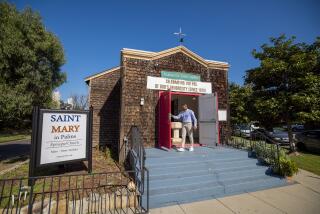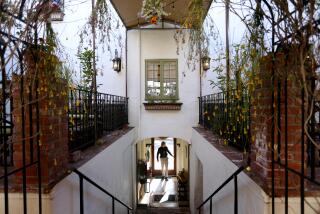Pasadena’s All Saints Episcopal Church and preservationists battle over architecture
In Pasadena’s historic civic district, there’s a conflict between two images of sacred space.
The dispute involves a church, but it’s a battle over architecture, not theology, that’s dividing residents of the well-heeled city.
For years the large and venerable All Saints Episcopal Church and its often-spotlighted rector, the Rev. J. Edwin Bacon, have been in a deadlock with preservationists who say the church’s expansion plans are intruding on the architectural history of the district.
The original Gothic Revival-style church built in 1923 stands across the street from Pasadena’s California- Mediterranean-style City Hall and within the confines of the Pasadena Civic Center District, which is listed on the National Register of Historic Places as an example of civic art in the “City Beautiful” architectural style of the 1920s.
All Saints leaders and congregation members said the parish, with its 3,500 congregants, 125 ministries and 13,000 meetings a year, has become increasingly cramped and needs new spaces to meet, worship and incubate local nonprofit start-ups.
Preservationists clarified their respect for the church and its history in the community. But they said the distinctly contemporary design created by architect Michael Palladino of Richard Meier & Partners Architects LLP — who worked on the Getty Center, among other high-profile projects — is out of context in the historic district.
“It’s needed, wanted and desired as a use — everybody supported that. You put it in a box that doesn’t fit and you have problems,” said Marsha Rood, a former Pasadena development administrator who has been a vocal opponent of the complex’s design.
In comments to the city, Rood and other preservationists said the new buildings’ aesthetics would intrude on the city’s carefully planned and cultivated “sacred civic place.”
Bacon and congregants said the contemporary lines of the new buildings were a natural choice for a church that prides itself as forward-thinking. The church has taken liberal stances on issues such as gay rights, immigration reform and opposition to the Iraq war.
“All Saints has always distinguished itself by taking ancient truths, scriptures and rituals and expressing [them] in a contemporary and relevant way,” Bacon said. “So it would make no sense for us to want to build a building that expands and extends our mission that wouldn’t be in a contemporary architectural vocabulary.”
The exterior of the original 1920s-era church campus buildings will remain untouched in the proposed $46-million renovation and expansion process, and Palladino said the new buildings will incorporate the Bouquet Canyon stone, stained glass, cast concrete and copper of the originals.
The church began actively planning for expansion in 1999, eventually laying out plans for a new three-building complex — later updated to include a fourth building — adjacent to the existing church. The new buildings will house office and meeting space, a youth and family center and a new worship space interspersed with outdoor plazas and gardens.
It proposed its 15-year master plan to the city in 2007. In December 2008, the process was put on hold when the city planning commission — in what Bacon called a surprise move — decided the project required a full environmental impact report.
Although church officials and Palladino said they were surprised by the vehemence of the opposition from community members, city planning staff said it’s nothing out of the ordinary in the aesthetics-conscious city.
“The community is very sensitive and very careful with large projects,” said Millie de la Cuba, principal planner of Pasadena’s community planning division.
The city publicly released its draft environmental report this week. The document raised concerns about the planned relocation of a historic hotel wall bounding the church property, but it took no issue with the design of the new buildings.
In the wake of the report, the church claimed vindication, but preservationists were not ready to concede. Sue Mossman, executive director of Pasadena Heritage, said preservationists will continue to speak out publicly in hopes of sending the church back to the drawing board.
The environmental impact report “does not in itself make a decision,” she said. “It’s the City Council who will make the decision.”
A public hearing on the environmental report is slated for Sept. 22. City staff said they expect the City Council to vote on the church’s conceptual design by the end of the year.
More to Read
Sign up for Essential California
The most important California stories and recommendations in your inbox every morning.
You may occasionally receive promotional content from the Los Angeles Times.











